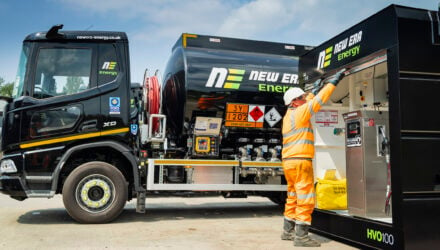Mercedes-Benz Trucks presented a truck with cameras instead of exterior outside mirrors back in 2014 with its study entitled “Mercedes-Benz Future Truck 2025”. In 2018, it was the first in the industry to introduce series production of MirrorCam – the first mirror camera system for trucks. A series-produced truck equipped with MirrorCam no longer had traditional main and wide-angle mirrors. Instead, it had a system consisting of two cameras attached to both sides of the roof frame as well as two portrait-format monitors attached to the A-pillars in the cab, together with the corresponding controls in the driver’s cab. A conscious decision was made to use two equally sized, 15-inch monitors on the driver’s and front passenger’s sides. This is because the larger the image of a moving object, the easier it is to judge its speed. For the driver to identify the image information relevant to the situation as quickly as possible, a complex, multi-quadrant view was also replaced by a single image.
Mercedes-Benz Trucks has now updated MirrorCam for the first time. With the second generation, available for the Actros and Arocs as well as eActros series since April 2022, Mercedes-Benz Trucks has evolved important details of the system, winning several Innovation Awards. Prof. Uwe Baake, Head of Product Development at Mercedes-Benz Trucks, explains: “The intensive discussions with our customers and their experiences from day-to-day operations formed the foundations for us to make further adjustments to individual technical parameters, thereby generating even greater added value, especially in terms of display and safety.”
In addition to improved aerodynamics and correspondingly lower fuel consumption and energy requirements, MirrorCam has brought about increased road safety, given that where the glass mirrors previously concealed large areas (‘blind spots’) to the sides of the A-pillar, MirrorCam does not obstruct the field of vision. This is particularly beneficial at junctions, when manoeuvring, and in tight bends. Furthermore, the electronic system uses functions such as semi-trailer tracking or special views for challenging manoeuvring tasks to make everyday operations easier for professional drivers.
Less is more: Shorter camera arms are beneficial
The exterior of the second MirrorCam generation stands out because the camera arms on both sides have been shortened by ten centimetres. This applies to both the narrower and wider cab and, among other advantages, allows drivers to reverse in a straight line more easily than with the first MirrorCam generation. This comes as a result of MirrorCam’s perspective now being even more akin to that of conventional glass mirrors. Shorter dimensions bring about another benefit because with the 2.5 metre-wide cab, the camera arm now protrudes no further than the kerb mirror which is within the driver’s sight. Collisions with objects at the edge of the road are now virtually impossible. As chassis widths are identical, this also applies to the 2.3 metre-wide cab variant.
 Further optimised image parameters on MirrorCam
Further optimised image parameters on MirrorCam
As part of the revision of the camera-based system, Mercedes-Benz Trucks has also evolved further features. For example, the revised MirrorCam arms now incorporate an enhanced housing design which further reduces the risk of debris obscuring the camera lens and causing undesirable visual effects. In addition, engineers at Mercedes-Benz Trucks have further optimised the tone mapping – tone mapping is a process in which an image is adapted so that a large range of tones are displayed correctly on a medium – reflected primarily as an improved contrast display. The camera system’s evolution in colour and brightness adaptation, which is already very bright in itself, means that the displays show the area relevant to the driving situation even more accurately when the vehicle is reversing into a dark or poorly lit facility, for example.
Committed to safety and driver convenience
These revisions result in an even higher added value for MirrorCam overall. Thanks to its supporting effect, the enhanced system can help to manage situations such as overtaking, manoeuvring, driving in poor visibility and darkness, cornering and passing narrow spaces even more safely and without causing stress. The existing advantages are still available, such as wide-angle mode when reversing, distance lines on the display for better assessing the distance from objects behind the vehicle being driven, camera image panning when cornering, and monitoring of the vehicle’s surroundings during rest periods.
The interaction between MirrorCam and the cornering assistant from Mercedes‑Benz Trucks has already proved helpful, especially in complex traffic situations and at confusing junctions. If, contrary to expectations, there is a risk that a truck driver fails to spot a cyclist or pedestrian when turning left, Sideguard Assist can – within its system limits – warn the driver as part of a multi-stage process, using the MirrorCam display to provide visual warnings.








